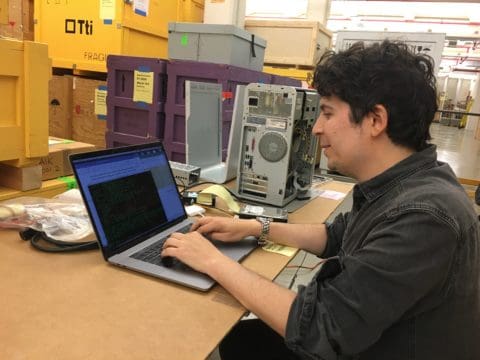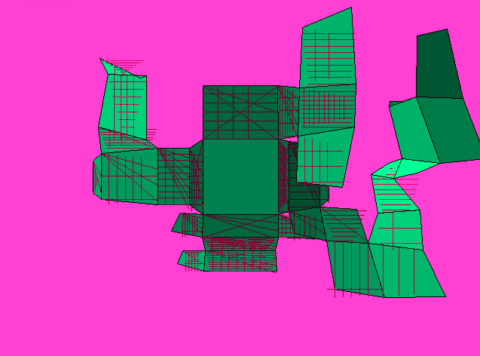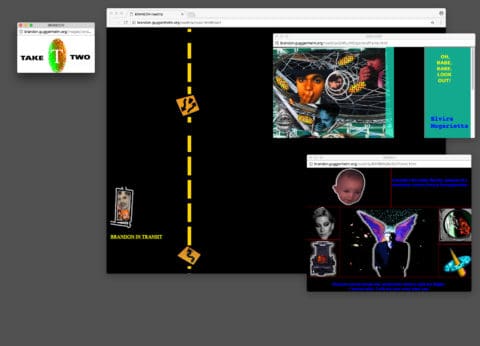The Solomon R. Guggenheim conservation department joined the “Fostering a Community of Practice: Software Preservation” cohort to look at documentation and metadata practices for computer-based artworks. Involvement in FCoP falls under the museum’s ongoing Conserving Computer-based Art initiative (CCBA) with project team members located in the conservation department. CCBA also involves collaboration with Professor Deena Engel and students in New York University’s Department of Computer Science. Our research partners at NYU have completed source code analysis of artworks and prototyped code migrations to restore artworks that are no longer accessible.
The term computer-based art (or sometimes software-based art) denotes artworks where software itself is employed as a creative medium and/or is integral to the exhibition of the work. The Guggenheim has twenty-eight computer-based artworks in its permanent collection at the time of this post, with some works over twenty years old. Artworks in the collection employ a variety of technologies to perform their artist-intended behaviors, including websites that use HTML and JavaScript, Adobe Flash animations, virtual reality headsets, custom-built microcontroller units, and computer-controlled industrial robots. By disseminating our practices and the challenges that our collection presents, we hope to provide resources for other cultural heritage institutions that acquire computer-based artworks.

Since the beginning of the FCoP project, the Guggenheim has progressed in developing its disk imaging workflow and its cataloging standards for physical and digital components of computer-based artworks. The August 2018 FCoP kickoff event in Mountain View, California served as an excellent opportunity to exchange ideas with fellow cohort members and with staff from the Computer History Museum, particularly on disk imaging and cataloging.
In the initial research for our collaborative project, we reviewed different metadata and cataloging approaches to both hardware and software (including SPN research on the use of metadata standards as well as discussions with Rhizome and FCoP cohort member, Living Computers Museum and Labs). We found that institutions are often using homegrown protocols and are not currently coalescing around a particular set of standards. After completing the software collections inventory exercise as part of FCoP, we understood the need to define documentation for recording software dependencies. Our methods for recording software dependencies remain provisional, but we are moving forward.

The topic of software dependencies has fed into recent departmental discussions about long-term monitoring of computer-based artworks for obsolescence, particularly web artworks, as standards on the internet are changing all the time. Two web artworks in the Guggenheim collection – John F. Simon Jr’s Unfolding Object (2002) and Shu Lea Cheang’s Brandon (1998-99) – have been restored. A third work, Mark Napier’s net.flag (2002), is currently undergoing restoration. All three artworks employed now-obsolete web technologies. The data was backed up and saved on a secure server, however, we must continue to track future obsolescence so appropriate action may be taken before artworks become inaccessible.

Involvement in FCoP brought CCBA Fellow Jonathan Farbowitz into conversation with Henry Zhu, a software developer who is particularly interested in strategies for maintenance. On his podcast Maintainers Anonymous, Henry suggested the potential for automated systems for monitoring web artworks, such as comparing screenshots, techniques already in use by current web developers.
We value perspectives on the latest developments in the field of software preservation through guest speakers and regular updates from the FCoP cohort, including discussions around the recent Code of Best Practices for Fair Use in Software Preservation and DMCA exemption for libraries, archives, and museums. Interdisciplinary knowledge exchange and collaboration have always been an important aspect of the CCBA initiative, and involvement in FCoP has connected us to practitioners outside the field of art conservation. For example, we spoke with Daina Bouquin, Head Librarian at the Center for Astrophysics, Harvard & Smithsonian, about how an artist questionnaire and interview model might be applied to interviewing scientists who deposit software used for experimental research into archival repositories.
Through this interdisciplinary research, we hope to contribute workflows and examples of how to catalog artworks in a collection management system (in our case TMS) and record software dependencies. Our extensive work on applying conservation ethics to code migration of web artworks from one programming language to another could also apply to software restorations in other cultural heritage institutions outside of museums.